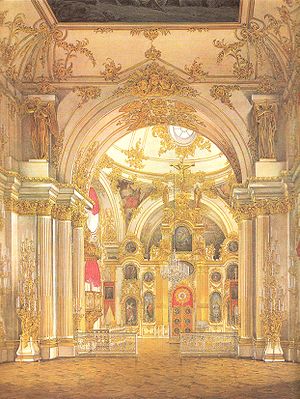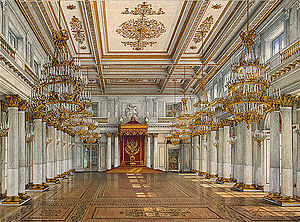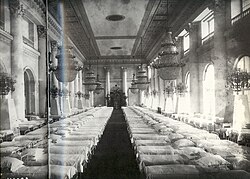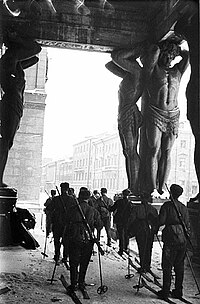The first Winter Palace, designed in 1711 for Peter the Great, by Domenico Trezzini who, 16 years later, was to design the third Winter Palace
The Winter Palace (Russian: Зимний дворец, tr. Zimnij dvorets, IPA: [ˈzʲimnʲɪj dvɐˈrʲɛts]) is a palace in Saint Petersburg that served as the official residence of the House of Romanov, previous emperors, from 1732 to 1917. The palace and its precincts now house the Hermitage Museum. Situated between Palace Embankment and Palace Square, adjacent to the site of Peter the Great's original Winter Palace, the present and fourth Winter Palace was built and altered almost continuously between the late 1730s and 1837, when it was severely damaged by fire and immediately rebuilt.[1] The storming of the palace in 1917, as depicted in Soviet art and in Sergei Eisenstein's 1928 film October, became a symbol of the October Revolution.
The emperors constructed their palaces on a monumental scale that aimed to reflect the might and power of Imperial Russia. From the palace, the tsars[2] ruled over 22,800,000 square kilometers (8,800,000 sq mi)[3][4] (almost 1/6 of the Earth's landmass) and 125 million subjects by the end of the 19th century. Several architects participated in designing the Winter Palace—most notably the Italian Bartolomeo Rastrelli (1700–1771)—in what became known as the Elizabethan Baroque style. The green-and-white palace has the overall shape of an elongated rectangle, and its principal façade is 215 metres (705 ft) long and 30 m (98 ft) high. The Winter Palace has been calculated to contain 1,886 doors, 1,945 windows, 1,500 rooms and 117 staircases.[5] Following a serious fire, the palace's rebuilding of 1837 left the exterior unchanged, but large parts of the interior were redesigned in a variety of tastes and styles, leading the palace to be described as a "19th-century palace inspired by a model in Rococo style".[6]
In 1905, the Bloody Sunday occurred when demonstrators marched toward the Winter Palace, but by this time the Imperial Family had chosen to live in the more secure and secluded Alexander Palace at Tsarskoe Selo (lit. "regal village"), and returned to the Winter Palace only for formal and state occasions. Following the February Revolution of 1917, the palace operated for a short time as the seat of the Russian Provisional Government, ultimately led by Alexander Kerensky. Later that same year a detachment of Red Guard soldiers and sailors stormed the palace—a defining moment in the birth of the Soviet state, overthrowing the Provisional Government.
https://en.wikipedia.org/wiki/Winter_Palace


As the formal home of the Russian Tsars, the palace was the setting for profuse, frequent and lavish entertaining. The dining table could seat 1000 guests, while the state rooms could contain up to 10,000 people—all standing, as no chairs were provided.[54] These rooms, halls and galleries were heated to such a temperature that while it was sub-zero outside, exotic plants bloomed within, while the brilliant lighting gave the ambiance of a summer's day.[55]
https://en.wikipedia.org/wiki/Winter_Palace
Imperial Hermitage Museum
After the death of Catherine the Great, the Hermitage had become a private treasure house of the Tsars, who continued collecting, albeit not on the scale of Catherine the Great. In 1850, the collection of Cristoforo Barbarigo was acquired. This collection from Republic of Venice brought into the Winter Palace further works by Titian, in addition to many 16th-century Renaissance works of art.
Nicholas I, conscious of the great art galleries in other European capitals, saw that Catherine the Great's Large Hermitage (15) was vastly expanded and transformed into a purpose-built public art gallery. In 1839, German architect Leo von Klenze drew up the plans and their execution was overseen by Vasily Stasov, assisted by Alexander Briullov and Nikolai Yefimov.[59][60] With so many architects involved there were inevitably many conflicts over the design and its execution throughout the 1840s, with the Tsar having frequently to act as moderator.[61] Eventually, after eleven years of building and architectural conflict, the first art museum in Russia, the Imperial Hermitage Museum, opened on 5 February 1852.[31] The trebeated facades of the building were inspired by Schinkelesque architecture. It was erected in grey marble round three courtyards and the complex is noted for the asymmetrical planning of its wings and floors.[59] By order of the Tsar, visitors to the museum were required to wear evening dress, even in the morning. The Tsar also decreed that grey top hats were "Jewish" and dress coats "revolutionary".[62] Having negotiated the dress code, what the public saw was a huge array of art, but only a fraction of the Imperial collection, as the Winter Palace and other Imperial palaces remained closed to the viewing public.
https://en.wikipedia.org/wiki/Winter_Palace
https://en.wikipedia.org/wiki/Winter_Palace
https://en.wikipedia.org/wiki/Winter_Palace
The Winter Palace was now a redundant and damaged building symbolic of a despised regime, facing an uncertain future. The Storming of the Winter Palace was a historical reenactment organised by the Bolsheviks on the 3rd anniversary in 1920. With thousands of Red Guards led by Lenin, and witnessed by 100,000 spectators, the reenactment has become one of the "best known" events of the Russian Revolution.
https://en.wikipedia.org/wiki/Winter_Palace
https://en.wikipedia.org/wiki/Winter_Palace
https://en.wikipedia.org/wiki/Winter_Palace
- Houses completed in 1837
- Palaces in Saint Petersburg
- Royal residences in Russia
- Russian Provisional Government
- Art gallery districts
- Hermitage Museum
- Palace Square
- Baroque architecture in Saint Petersburg
- Baroque palaces
- 1905 Russian Revolution
- Russian Revolution
- Cultural heritage monuments of federal significance in Saint Petersburg
- Bartolomeo Rastrelli buildings
https://en.wikipedia.org/wiki/Winter_Palace













No comments:
Post a Comment